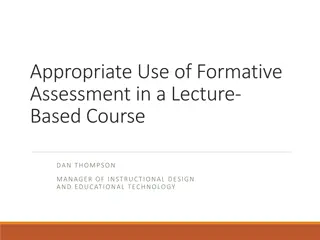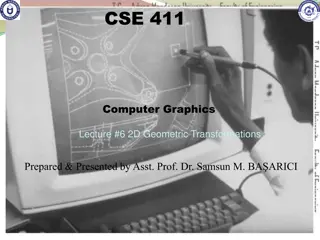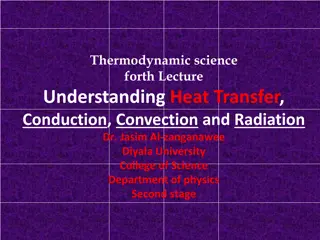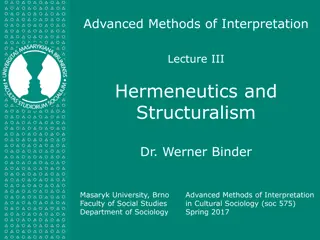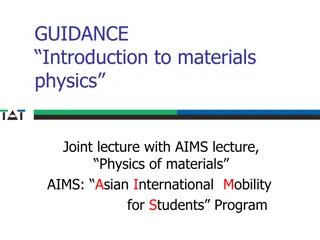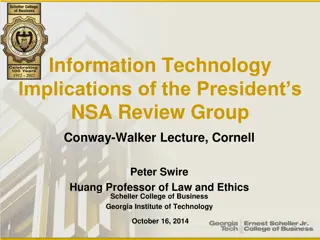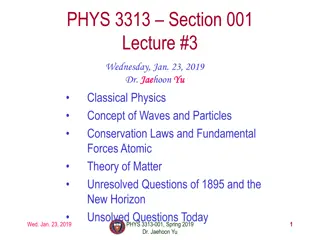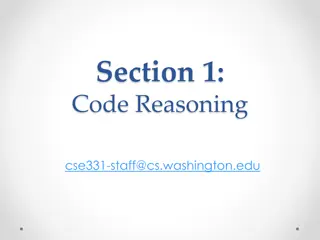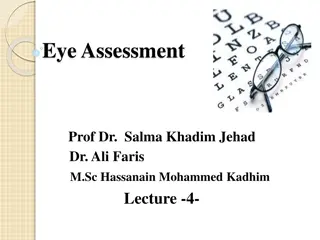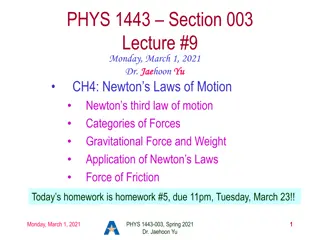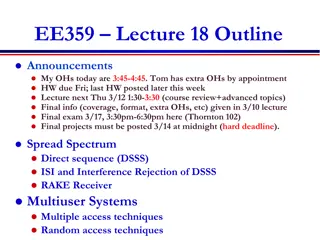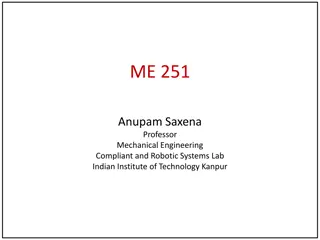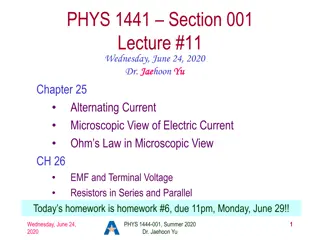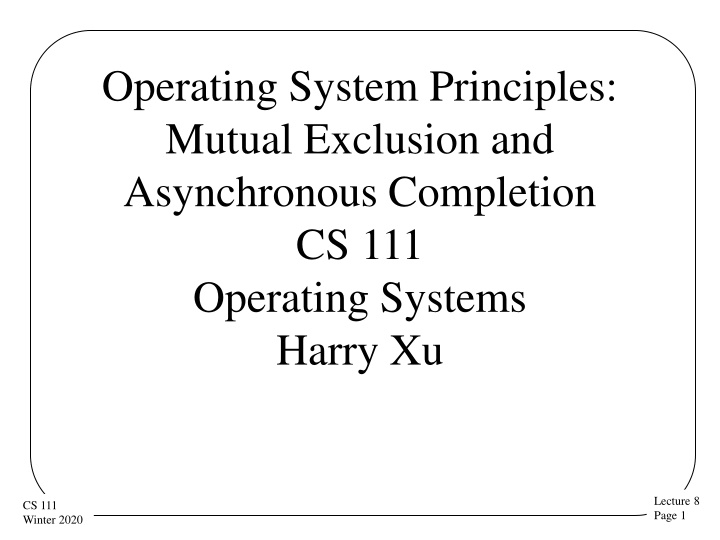
Understanding Mutual Exclusion in Operating Systems
Explore the principles of mutual exclusion and asynchronous completion in operating systems. Learn how critical sections can cause issues when multiple threads access them simultaneously and discover techniques like hardware mutual exclusion to protect critical sections effectively.
Download Presentation

Please find below an Image/Link to download the presentation.
The content on the website is provided AS IS for your information and personal use only. It may not be sold, licensed, or shared on other websites without obtaining consent from the author. If you encounter any issues during the download, it is possible that the publisher has removed the file from their server.
You are allowed to download the files provided on this website for personal or commercial use, subject to the condition that they are used lawfully. All files are the property of their respective owners.
The content on the website is provided AS IS for your information and personal use only. It may not be sold, licensed, or shared on other websites without obtaining consent from the author.
E N D
Presentation Transcript
Operating System Principles: Mutual Exclusion and Asynchronous Completion CS 111 Operating Systems Harry Xu Lecture 8 Page 1 CS 111 Winter 2020
Outline Mutual exclusion Asynchronous completions Lecture 8 Page 2 CS 111 Winter 2020
Mutual Exclusion Critical sections can cause trouble when more than one thread executes them at a time Each thread doing part of the critical section before any of them do all of it Preventable if we ensure that only one thread can execute a critical section at a time We need to achieve mutual exclusion of the critical section Lecture 8 Page 3 CS 111 Winter 2020
Critical Sections in Applications Most common for multithreaded applications Which frequently share data structures Can also happen with processes Which share operating system resources Like files Avoidable if you don t share resources of any kind But that s not always feasible Lecture 8 Page 4 CS 111 Winter 2020
Recognizing Critical Sections Generally involves updates to object state May be updates to a single object May be related updates to multiple objects Generally involves multi-step operations Object state inconsistent until operation finishes Pre-emption compromises object or operation Correct operation requires mutual exclusion Only one thread at a time has access to object(s) Client 1 completes before client 2 starts Lecture 8 Page 5 CS 111 Winter 2020
Critical Sections and Atomicity Using mutual exclusion allows us to achieve atomicity of a critical section Atomicity has two aspects: 1. Before or After atomicity A enters critical section before B starts B enters critical section after A completes There is no overlap 2. All or None atomicity An update that starts will complete An uncompleted update has no effect Correctness generally requires both Lecture 8 Page 6 CS 111 Winter 2020
Options for Protecting Critical Sections Turn off interrupts We covered that in the last lecture Prevents concurrency Avoid shared data whenever possible Protect critical sections using hardware mutual exclusion In particular, atomic CPU instructions Software locking Lecture 8 Page 7 CS 111 Winter 2020
Avoiding Shared Data A good design choice when feasible Don t share things you don t need to share But not always an option Even if possible, may lead to inefficient resource use Sharing read only data also avoids problems If no writes, the order of reads doesn t matter But a single write can blow everything out of the water Lecture 8 Page 8 CS 111 Winter 2020
Atomic Instructions CPU instructions are uninterruptable What can they do? Read/modify/write operations Can be applied to 1-8 contiguous bytes Simple: increment/decrement, and/or/xor Complex: test-and-set, exchange, compare-and-swap Can we do entire critical section in one atomic instruction? Usually not feasible Lecture 8 Page 9 CS 111 Winter 2020
Preventing Concurrency Via Atomic Instructions CPU instructions are hardware-atomic So if you can squeeze a critical section into one instruction, no concurrency problems With careful design, some data structures can be implemented this way Limitations Unusable for complex critical sections Unusable as a waiting mechanism Lecture 8 Page 10 CS 111 Winter 2020
Locking Protect critical sections with a data structure Locks The party holding a lock can access the critical section Parties not holding the lock cannot access it A party needing to use the critical section tries to acquire the lock If it succeeds, it goes ahead If not . . .? When finished with critical section, release the lock Which someone else can then acquire Lecture 8 Page 11 CS 111 Winter 2020
Using Locks Remember this example? thread #2 thread #1 counter = counter + 1; What looks like one instruction in C gets compiled to: counter = counter + 1; mov counter, %eax add $0x1, %eax mov %eax, counter Three instructions . . . How can we solve this with locks? Lecture 8 Page 12 CS 111 Winter 2020
Using Locks For Mutual Exclusion pthread_mutex_t lock; pthread_mutex_init(&lock, NULL); if (pthread_mutex_lock(&lock) == 0) { counter = counter + 1; pthread_mutex_unlock(&lock); } Now the three assembly instructions are mutually exclusive Lecture 8 Page 13 CS 111 Winter 2020
How Do We Build Locks? The very operation of locking and unlocking a lock is itself a critical section If we don t protect it, two threads might acquire the same lock Sounds like a chicken-and-egg problem But we can solve it with hardware assistance Individual CPU instructions are atomic So if we can implement a lock with one instruction . . . Lecture 8 Page 14 CS 111 Winter 2020
Single Instruction Locks Sounds tricky The core operation of acquiring a lock (when it s free) requires: 1. Check that no one else has it 2. Change something so others know we have it Sounds like we need to do two things in one instruction No problem hardware designers have provided for that Lecture 8 Page 15 CS 111 Winter 2020
Atomic Instructions Test and Set A C description of a machine language instruction REAL Instructions are silicon, not C!!! bool TS( char *p) { bool rc; rc = *p; *p = TRUE; return rc; } /* set the value to be TRUE /* return the value before we set it */ /* note the current value */ */ if !TS(flag) { } /* We have control of the critical section! */ If rc was true, someone else already ran TS. They got the lock! If rc was false, nobody else ran TS. We got the lock! Lecture 8 Page 16 CS 111 Winter 2020
Atomic Instructions Compare and Swap Again, a C description of machine instruction bool compare_and_swap( int *p, int old, int new ) { if (*p == old) { /* see if value has been changed *p = new; /* if not, set it to new value return( TRUE); /* tell caller he succeeded } else /* someone else changed *p return( FALSE); /* tell caller he failed } */ */ */ */ */ if (compare_and_swap(flag,UNUSED,IN_USE) { /* I got the critical section! */ } else { /* I didn t get it. */ } Lecture 8 Page 17 CS 111 Winter 2020
Using Atomic Instructions to Implement a Lock Assuming C implementation of test and set bool getlock( lock *lockp) { if (TS(lockp) == 0 ) return( TRUE); else return( FALSE); } void freelock( lock *lockp ) { *lockp = 0; } Lecture 8 Page 18 CS 111 Winter 2020
What Happens When You Dont Get the Lock? You could just give up But then you ll never execute your critical section You could try to get it again But it still might not be available So you could try to get it again . . . Lecture 8 Page 19 CS 111 Winter 2020
Spin Waiting The computer science equivalent Check if the event occurred If not, check again And again And again . . . Lecture 8 Page 20 CS 111 Winter 2020
Spin Locks: Pluses and Minuses Good points Properly enforces access to critical sections Assuming properly implemented locks Simple to program Dangers Wasteful Spinning uses processor cycles Likely to delay freeing of desired resource Spinning uses processor cycles Bug may lead to infinite spin-waits Lecture 8 Page 21 CS 111 Winter 2020
The Asynchronous Completion Problem Parallel activities move at different speeds One activity may need to wait for another to complete The asynchronous completion problem is: How to perform such waits without killing performance? Lecture 8 Page 22 CS 111 Winter 2020
Spinning Sometimes Makes Sense 1. When awaited operation proceeds in parallel A hardware device accepts a command Another core releases a briefly held spin-lock 2. When awaited operation is guaranteed to be soon Spinning is less expensive than sleep/wakeup 3. When spinning does not delay awaited operation Burning CPU delays running another process Burning memory bandwidth slows I/O 4. When contention is expected to be rare Multiple waiters greatly increase the cost Lecture 8 Page 23 CS 111 Winter 2020
Yield and Spin Check if your event occurred Maybe check a few more times But then yield Sooner or later you get rescheduled And then you check again Repeat checking and yielding until your event is ready Lecture 8 Page 24 CS 111 Winter 2020
Problems With Yield and Spin Extra context switches Which are expensive Still wastes cycles if you spin each time you re scheduled You might not get scheduled to check until long after event occurs Works very poorly with multiple waiters Potential unfairness Lecture 8 Page 25 CS 111 Winter 2020
Fairness and Mutual Exclusion What if multiple processes/threads/machines need mutually exclusive access to a resource? Locking can provide that But can we make guarantees about fairness? Such as: Anyone who wants the resource gets it sooner or later (no starvation) Perhaps ensuring FIFO treatment Or enforcing some other scheduling discipline Lecture 8 Page 26 CS 111 Winter 2020
How Can We Wait? Spin locking/busy waiting Yield and spin Either spin option may still require mutual exclusion And any time spent spinning is wasted And fairness may be an issue Completion events Lecture 8 Page 27 CS 111 Winter 2020
Completion Events If you can t get the lock, block Ask the OS to wake you when the lock is available Similarly for anything else you need to wait for Such as I/O completion Or another process to finish its work Implemented with condition variables Lecture 8 Page 28 CS 111 Winter 2020
Condition Variables Create a synchronization object associated with a resource or request Requester blocks and is queued awaiting event on that object Upon completion, the event is posted Posting event unblocks the waiter exit running create wait post blocked ready Lecture 8 Page 29 CS 111 Winter 2020
Condition Variables and the OS Generally the OS provides condition variables Or library code that implements threads does It blocks a process or thread when condition variable is used Moving it out of the ready queue It observes when the desired event occurs It then unblocks the blocked process or thread Putting it back in the ready queue Possibly preempting the running process Lecture 8 Page 30 CS 111 Winter 2020
Handling Multiple Waits Threads will wait on several different things Pointless to wake up everyone on every event Each should wake up only when his event happens So OS (or thread package) should allow easy selection of the right one When some particular event occurs But several threads could be waiting for the same thing . . . Lecture 8 Page 31 CS 111 Winter 2020
Waiting Lists Suggests each completion event needs an associated waiting list When posting an event, consult list to determine who s waiting for that event Then what? Wake up everyone on that event s waiting list? One-at-a-time in FIFO order? One-at-a-time in priority order (possible starvation)? Choice depends on event and application This isn t the ready queue! Lecture 8 Page 32 CS 111 Winter 2020
Who To Wake Up? Who wakes up when a condition variable is signaled? pthread_cond_signal at least one blocked thread pthread_cond_broadcast all blocked threads The broadcast approach may be wasteful If the event can only be consumed once Potentially unbounded waiting times A waiting queue would solve these problems Each post wakes up the first client on the queue Lecture 8 Page 33 CS 111 Winter 2020
Evaluating Waiting List Options Effectiveness/Correctness Should be very good Progress There is a trade-off involving cutting in line Fairness Should be very good Performance Should be very efficient Depends on frequency of spurious wakeups Lecture 8 Page 34 CS 111 Winter 2020
Locking and Waiting Lists Spinning for a lock is usually a bad thing Locks should probably have waiting lists A waiting list is a (shared) data structure Implementation will likely have critical sections Which may need to be protected by a lock This seems to be a circular dependency Locks have waiting lists Which must be protected by locks What if we must wait for the waiting list lock? Lecture 8 Page 35 CS 111 Winter 2020
A Possible Problem The sleep/wakeup race condition Consider this sleep code: And this wakeup code: void wakeup( eventp *e) { struct proce *p; e->posted = TRUE; p = get_from_queue(&e-> queue); if (p) { p->runstate &= ~BLOCKED; resched(); } /* if !p, nobody s waiting */ } What s the problem with this? void sleep( eventp *e ) { while(e->posted == FALSE) { add_to_queue( &e->queue, myproc ); myproc->runstate |= BLOCKED; yield(); } } Lecture 8 Page 36 CS 111 Winter 2020
A Sleep/Wakeup Race Let s say thread B has locked a resource and thread A needs to get that lock So thread A will call sleep()to wait for the lock to be free Meanwhile, thread B finishes using the resource So thread B will call wakeup()to release the lock No other threads are waiting for the resource Lecture 8 Page 37 CS 111 Winter 2020
The Race At Work Thread A Thread B void sleep( eventp *e ) { Yep, somebody s locked it! while(e->posted == FALSE) { void wakeup( eventp *e) { struct proce *p; CONTEXT SWITCH! e->posted = TRUE; p = get_from_queue(&e-> queue); if (p) { Nope, nobody s in the queue! } /* if !p, nobody s waiting */ CONTEXT SWITCH! } add_to_queue( &e->queue, myproc ); myproc->runsate |= BLOCKED; yield(); The effect? } } Thread A is sleeping But there s no one to wake him up Lecture 8 Page 38 CS 111 Winter 2020
Solving the Problem There is clearly a critical section in sleep() Starting before we test the posted flag Ending after we put ourselves on the notify list During this section, we need to prevent: Wakeups of the event Other people waiting on the event This is a mutual-exclusion problem Fortunately, we already know how to solve those Work through it for yourselves Lecture 8 Page 39 CS 111 Winter 2020





